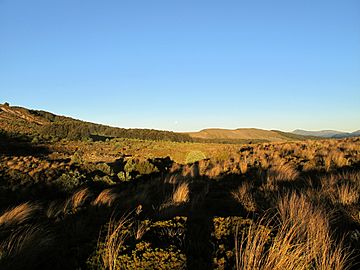Kaimanawa Range facts for kids
Quick facts for kids Kaimanawa Mountains |
|
|---|---|
| Kaimanawa Range | |

Sunset in the Kaimanawa Range
|
|
| Highest point | |
| Elevation | 1,727 m (5,666 ft) |
| Geography | |
|
Lua error in Module:Location_map at line 420: attempt to index field 'wikibase' (a nil value).
|
|
The Kaimanawa Mountains are a range of mountains in the middle of New Zealand's North Island. They stretch for about 50 kilometres (31 miles) from northeast to southwest. These mountains are mostly in wild, empty areas south of Lake Taupō and east of a road called the "Desert Road." Their slopes are part of the North Island Volcanic Plateau, which is an area formed by ancient volcanoes.
The name Kaimanawa means "breath for food" in Māori. This translation comes from the New Zealand Ministry for Culture and Heritage.
The land around the Kaimanawa Mountains is quite wild. To the west, where the Rangipo Desert is found, the soil is not very good for growing things. To the east, the soil is better, but the land is very rough and uneven. A special group of wild horses, known as Kaimanawa horses, live and roam freely in these mountains.
Unlike most mountain ranges in New Zealand, parts of the Kaimanawa Range are privately owned. Large areas of the nearby Rangipo Desert are used by the New Zealand Army for training exercises.
The Kaimanawa Wall: A Natural Mystery
Inside the Kaimanawa State Forest, there's a rock formation known as the Kaimanawa Wall. It looks like a wall made of neatly stacked blocks.
Some people believe this wall was built by humans a long time ago. There's even a popular idea that it was made by a civilization that lived in New Zealand before the Māori arrived. This idea is considered a pseudoscience theory, meaning it's not based on scientific evidence.
However, experts have studied the Kaimanawa Wall. An anthropologist (someone who studies human societies) and a geologist (someone who studies rocks and the Earth) both looked at the formation. They found no proof that humans built it.
Neville Ritchie, an anthropologist from the New Zealand Department of Conservation, noticed tiny matching bumps and dips along the "joints" (the lines between the blocks). This showed that the blocks fit together too perfectly to have been cut and placed by people. He also saw that the lines were not perfectly straight or even, which would be unusual for a human-made wall.
Peter Wood, a geologist from the Institute of Geological and Nuclear Sciences, also studied the wall. He concluded that the blocks are natural fractures in a type of volcanic rock. This rock is called "Jointed-Rangitaiki-Ignimbrite" and is about 330,000 years old. It's very common in the Taupō Volcanic Zone.
These fractures formed naturally when the hot volcanic rock cooled down and shrank after a volcanic eruption. Both up-and-down and side-to-side cracks are common in this type of rock. So, the Kaimanawa Wall is a fascinating example of how nature can create amazing shapes!
See also
 In Spanish: Montes Kaimanawa para niños
In Spanish: Montes Kaimanawa para niños


